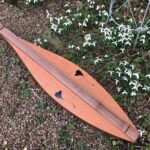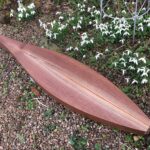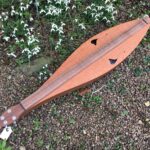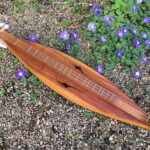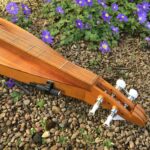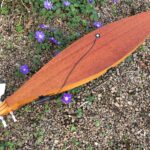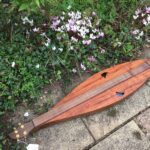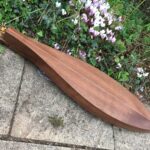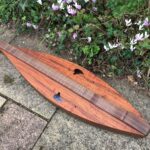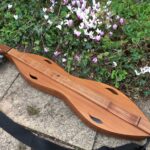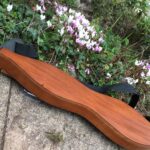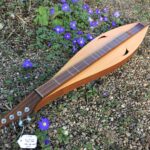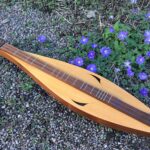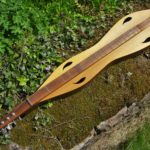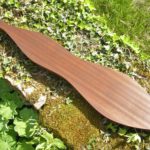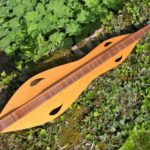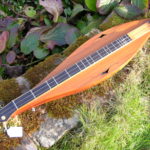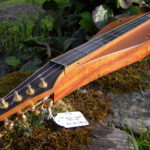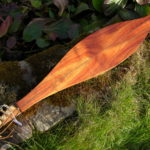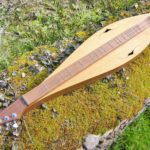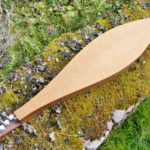Ron Ewing Dulcimers – some unusual shapes!
Some lovely and unusual dulcimers from Ohio master craftsman Ron Ewing. Ron has been building superb and distinctive instruments for over 40 years. He was the first to develop a professional quality dulcimer capo 30 years ago which is still regarded as the gold standard. He is also credited with developing the earliest – and still arguably the best – higher register dulcimers. His dulcimettes (tuned an octave above the normal dulcimer, usually DAD) and baritone dulcimettes (tuned an octave above the baritone dulcimer, usually AEA) are justly famous.
As a shy youngster growing up in Ohio during the late 60s, Ron was first captivated by the dulcimer playing of Richard Farina. Looking to understand how to make a dulcimer for himself, he came across retired engineer, dulcimer builder and player Chet Hines. He pestered Chet into letting him help with the dulcimer building then, as Chet’s arthritis grew worse, he took over the building side completely and made around 200 dulcimers under Hines’ label. Developing into an accomplished player of traditional music, he moved in 1975 to the musical commune in Connecticut which was the home of Sandy and Caroline Paton and their Folk Legacy Records. They encouraged him to make more of his own instruments and to improve his business skills. He also found his dulcimers being sold at fairs alongside those of famous N Carolina father and son makers, Leonard and Clifford Glenn. At this time, his adventurous chordal playing led him to make his first dulcimettes and capos, and experiment with 1½ and ½ frets (of which he remains an important advocate). His dulcimers are known for their superb workmanship, their combination of woods with different sound characteristics, and their distinctive sweeping shapes with elegant, angular soundholes and headstocks.
2.304 2022 Ewing Teardrop Baritone 4 string #D1070 £Sold
Rectangular printed label “DULCIMERS/ by Ron Ewing/ D 1070 1/4/22 [h/w] / 224 East Maynard/ Columbus, OH 43202/ [tel. no. & website address]”. Model B-TR4 with Trailing heart soundholes and R-shaped head.
Very attractive walnut body, bookmatched on back and sides, with clever use of striated sapwood colours and reddish/brown purfling on back. Stunning orangey/cell-like patterned lacewood top, set off with trailing heart soundholes. Walnut R-head with chrome Gotohs – also chrome strap buttons. Walnut single piece fingerboard with mother of pearl markers at frets 3, 7, 10, 14. 1+, 6+, 8+ and 13+ frets present. Ebony ‘nut’/zero fret and compensated, floating (moveable) bridge. Copper pin string anchors. Overall length 36¾”, single bout 7½”, depth 2⅛”, FBW 1½”, VSL 29¼” (long), weight 2lb 06oz (1080g). 1+, 6+, 8+ and 13+ frets. Original strings 14/14, 20w, 32w.
Immense sustain with a light and responsive body. The walnut gives some warmth while the lacewood adds a little edge. Easy action and very playable, given the long scale and higher tension strings which drive the volume and produce good tone. Excellent balance and intonation. A pretty instrument, but more importantly, one of the nicest sounding baritones I’ve had the pleasure of playing. This has been used for a year and come back to me only because of ill-health. In excellent condition, with just a few imperceptible marks high up on the fingerboard. This represents real value in a top end baritone.
Click on images below to enlarge.
2.300 2015 Custom Baritone 4 String Hourglass #D943 £Sold
Rectangular printed label “DULCIMERS/ by Ron Ewing/ [h/w] D943 9/27/15 / 224 East Maynard/ Columbus, OH 43202/ [tel. no. & website address]”.
Larger baritone Aorell body (half-teardrop, half hourglass), with a single piece mahogany back, nice evenly-grained walnut bookmatched sides and a dark cedar top. Walnut S-head design with trailing hearts on one side and curly hearts on the other. Gold fittings, including quality Gotohs and strap buttons. Ebony nut/zero fret and floating, compensated ebony bridge. Brass fret markers at 3, 7, 10 and 14. Extra frets at 0+, 1+, 6+, 8+, and 13+. Copper pins in the tail for loop- or ball-end strings. Overall length 37¾”, UB 5½”, LB 7½”, depth 2¼”, FBW 1½”, VSL 29¼” (long), weight 2lb 7 oz (1112g). 0+, 1+, 6+, 8+ and 13+ frets. Current strings 11, 14, 24w, 30w.
This one is special – and not just because of its exciting shape and real depth of tone. It’s currently strung as a MAX DAD set-up, i.e. ADAd. This equidistant arrangement allows the playing of normal DAD chords, with the option of dropping down below the normal bass D if required. Could be re-configured in minutes to a standard baritone AEA set-up if preferred.
2.266 (ex-2.45) Ron Ewing Elliptical Dulcimer #22 4 String, 3 Course £Sold
Handwritten inside on back: “Ron Ewing/ #22 /July 1977”. Very early instrument from this important and distinctive builder, now based in Ohio. Ron made this for one of Sandy Paton’s birthdays, when Ron was working for Folk Legacy Records. Sandy was the co-founder of the label. His wife, Caroline, also played the dulcimer. Their son, David, from whom I bought the dulcimer, is best known as an English Concertina player.
Even this early in his career, Ron was exploring the potential of mixing woods with different sound characteristics. This one has a western red cedar top, mahogany back and maple sides. The thin and lively top has fine ‘Trailing Diamond’ soundholes. There is faint evidence that these unbraced designs have needed strengthening in the past. Sassafras or white oak fingerboard with zero fret and 6+ fret (no 13+). Headstock and tailblock are a 5 piece laminate of mahogany and maple, the former with a low, stylised scroll. Originally Grover Sta-Tite friction tuners, now replaced with good quality banjo planetary pegs, complete with matching wooden spacers and pearl buttons. The nut has been cut for 4 equidistant or 3 course string layouts, floating triangular-section ebony bridge. Quite heavy bracing, but no lining. Fitted with a K&K contact pickup on the back, linked to a ¼” jack housing mounted on the far side. Overall length 34½”, single bout 6½”, depth 1¾”, FBW 1⅜”, VSL 27½”, weight 1lb 10oz (742g). 6+ fret.
An outstanding early handbuilt dulcimer by a master craftsman – and was one of John Shaw’s main performance dulcimers. Even though it shows a few signs of a full and active life, it is still in good condition and ready to go. It has good volume and a well-balanced, clear tone; excellent intonation; and geared tuners which suit its sleek style. This is an instrument suitable for players of all abilities, but will best be appreciated by those whose playing has progressed to more challenging material.
Click on images below to enlarge.
2.251 (formerly 4.29) 2020 Custom Order Ewing 4 String Teardrop D1043 £Sold
Usual modern oblong label “DULCIMERS/ by Ron Ewing/ [h/w] D1043 8/4/20 / 224 East Maynard/ Columbus, OH 43202/ [tel. no. & website address]”.
This is Ron’s bigger, baritone body but with a conventional scale length and standard tuning. Spectacular flecked, curly koa top in various hues of red and gold with trailing heart soundholes. Straight-grained walnut body, bookmatched on back and sides, with central purfling strip. R-head flat headstock with good quality gold Gotoh tuners and gold strap buttons. Walnut fingerboard (no overlay) with brass dot markers at frets 3, 7, 10 & 14. 1+, 6+, 8+, 13+ frets present. Zero fret with brown/black ebony (?) ‘nut’ and fully compensated, floating bridge – latter has been raised slightly. Copper pin string anchors for loop and ball-end strings.
Overall length 36½ [vs std. 35½]”, LB 7⅞”, depth 2⅛”, FBW 1⅝”, VSL 27¾” (medium), weight 2lb 5 oz (1063g). 1+, 6+, 8+ and 13+ frets. Original strings 12/[12], 15, 24w.
Plenty of depth with the larger body emphasises the mids and bass. Clearly articulated notes as always, responsive to vibrato and should mellow and sweeten as it continues to ages. A very handsome instrument with plenty of character. After a year’s busy usage, body is immaculate; slight wear on the lower frets under the melody string; some light pick marks on the fingerboard around the 2nd octave.
Click on images below to enlarge.
2.225 1998 Hourglass #565 £Sold
Usual modern Ewing label “Dulcimers/ by Ron Ewing/ [h/w] # 565 5/11/98/ [address…tel. no. but no website]”. Standard hourglass body with single piece mahogany back, cherry sides and close-grained red cedar top; S-head flat headstock with teardrop soundholes. Chrome Gotoh tuners and chrome strap buttons. Walnut fingerboard (no overlay) with silver metal dot markers at frets 3, 7, 10, 14. 6+ and 13+ frets. Ebony ‘nut’ (with zero fret) and floating, compensated bridge. Copper pin string anchors on convex, slightly indented tail. Overall length 35″, upper bout 5⅞”, lower bout 8″, depth 2¼”, FBW 1⅝”, VSL 26¼ (short/medium scale), weight 1lb 15oz (879g). Strings now 12, 16, 27w. 6+ and 13+ frets.
Good condition, with just a few small dings on the cedar top. The light, rigid body makes for a nicely responsive dulcimer, with excellent harmonics. Well balanced, but has quite a clear, high-end attack. Easy action despite quite heavy strings, thus giving wide options for power and styles of playing.
Click on images below to enlarge.
2.238 1989 Ewing Teardrop #TF265 £Sold
Oblong printed label, “DULCIMERS/ by Ron Ewing/ TF 265 [h/w] 4/26/89.”
Almost elliptical teardrop with very fine-grained spruce top, walnut sides and single-piece flamed white oak back. Darker walnut F-head, fitted with a row of chrome Gotoh tuners, and Crescent style soundholes. Walnut one piece fingerboard with ebony ‘nut’/zero fret and ebony compensated floating bridge. Copper pins as string anchors, chrome strap buttons. Overall length 35½”, upper bout n/a, lower bout 6¾”, depth 1⅞”, FBW 1½”, VSL 26⅝ (medium scale), weight 1lb 15oz (878g). Strings now 12, 15, 25w. 6+ and 13+ frets.
Modernistic, slightly angular design suits this elliptical shape. The fairly large body also gives it a full sound with plenty of volume, but also good clarity. As always, very accurate intonation. A good responsive dulcimer.
Click on images below to enlarge.
2.160 1986 Hourglass £Sold
Handwritten # and date on printed label: “Dulcimers/ by Ron Ewing/ 234 east duncan/ Columbus, OH 43202/ HM181 12/20/86”. Narrow bouted hourglass shape with solid wood, dark mahogany body (single piece back) and spruce top. Tear shaped soundholes; unusual narrow, flat headstock with four-on-a-plate open-geared nickel tuners. Slightly concave endblock with mushroom-headed pins as string anchors. Rather narrow fretboard with 6+ and 13+ frets, thin, compensated floating bridge and nut-string guide – both made of rosewood. Zero fret. Overall length 35″, upper bout 4½”, lower bout 6⅝”, depth 2”, FBW 1⅜”, VSL 26⅛ (shortish scale), weight 1lb 07oz (665g). Strings now 12, 14, 24w. 6+ and 13+ frets.
Very clean condition for its age, with just a few pressure marks on the top and front edge. Sounds clean and well-defined, on the bright side with some volume for a small body. Good intonation. …And, just for nerds like me, it’s the very next dulcimer built after 2.81 below!
2.104 1991 Ron Ewing Custom 4 String Tearell – £Sold
Handwritten on printed label, “DULCIMERS/ by Ron Ewing/ LF4 351 10/22/91/ 224 E Maynard Street/Columbus, OHIO/ [tel. no.]”. Tearell shape (mixture of elliptical and teardrop sides) with Trailing Diamond soundholes. Beautiful rich, red koa body, bookmatched on the back with a central black/white/black purfling strip. Close-grained reddish cedar top. Ebony fingerboard and headstock overlay with ebony “nut” and floating, compensated bridge. Brass markers at frets 3, 7, 10 and 14. Extra 6+ and 13+ frets. Good quality gold Gotoh (?) tuners. Mushroom-headed pins for string anchor, positioned low down the endblock, with strings running over a curved tail. Hitch pins at each end of the nearside face of the fingerboard, to allow one of the doubled melody strings to be demounted temporarily if required. Overall length 35 [34½]”, single bout 6⅝ [6¾]”, depth 2 [1⅞]”, FBW 1½”, VSL 26¼ (shortish scale), weight 1lb 14oz (864g) [older teardrop below for comparison]. Strings now 12, 15, 26w. 6+ and 13+ frets.
This is a very well-made dulcimer which looks great. Its sound and feel is even better, with plenty of punch when required, clear note definition and sweetness/responsiveness as appropriate. Given its compact size and the (optional) shorter scale length, this should be an attractive proposition for the advanced or progressing player who would prefer less of a stretch.
2.81 1986 Ron Ewing – 4 String Teardrop – £Sold
A pretty and unusual dulcimer from Ohio master craftsman Ron Ewing. Ron has been building superb and distinctive instruments for over 40 years. He was the first to develop a professional quality dulcimer capo 30 years ago which is still regarded as the gold standard. He is also credited with developing the earliest – and still arguably the best – higher register dulcimers. His dulcimettes (tuned an octave above the normal dulcimer, usually DAD) and baritone dulcimettes (tuned an octave above the baritone dulcimer, usually AEA) are justly famous.
Handwritten # and date on printed label: “Dulcimers/ by Ron Ewing/ 234 east duncan/ Columbus, OH 43202/ TF180 12/11/86”.
Spruce or western red cedar top with elongated Trailing Diamonds soundholes and angular walnut F-head with four good quality, in-line, sealed chrome tuners. Probably walnut sides with figured quarter-sawn white oak or possibly sassafras single piece back. Small brass position dots at frets 3, 7, 10, 14; complete with 6+ and 13+ frets. Wood (ebony?) guide/nut with zero fret and fully compensated, ebony floating bridge. Mushroom-headed pins for string anchor, positioned low down the endblock, with strings running over a curved tail. Strap buttons at each end.
Overall length 34½”, single bout 6¾”, depth 1⅞”, FBW 1½”, VSL 26¼ (shortish scale), weight 1lb 12oz (804g). Strings now 11/11, 15, 24w. 6+ and 13+ frets.
A simple but striking design and an excellent balanced sound. This has been well used, as befits such a high quality dulcimer, but it has also been well looked after. A small nick on the end of the headstock is visible in the pictures. It has good volume and tone, excellent intonation with its compensated bridge and plays very easily. It would suit both fingerstyle and plectrum players. This handcrafted instrument is not to be confused with even good quality standardised workshop dulcimers. It is suitable for players of all abilities, but will best be appreciated by those whose playing has progressed to more challenging material.

